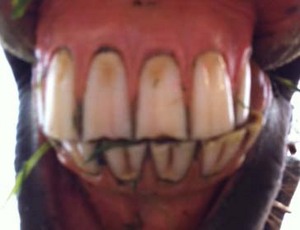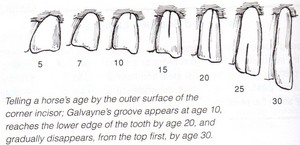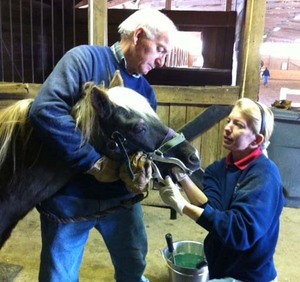Healthy teeth make a happy horse

Eleven year old horse's incisor teeth, with grass.
Kathy Lundberg | Contributor
“Don’t look a gift horse in the mouth!” Although one abhors seeming ungraciously to the giver, it is always a good idea to look that horse in the mouth, so you know what you are getting into by accepting the generous gift.
Examination of the teeth by a knowledgeable person can fairly closely estimate a horse’s age, and give an indication of what kind of care the animal has received. Teeth do not lie, and so you will get useful information “straight from the horse’s mouth.”
Like people, horses have incisors, premolars and molars (also called “cheek teeth”). Male horses also have canine teeth, but female horses usually do not. This is why most male horses have 40 teeth, and most female horses have 36.
About half of horses also have “wolf teeth” — vestigial remnants of the first premolars. When present, they are usually found on the top jaw (maxilla), and only rarely on the upper jaw (mandibula). Wolf teeth may be shed spontaneously but often are removed to prevent interference with the bit. Sometimes wolf teeth are removed from male horses at the time of gelding (about one year of age, while the horse is sedated.
Between the incisors and cheek teeth are the interdental spaces. This is where the bit of the bridle rests.

Estimating a horse's age by the appearance of the teeth
Image from Storey's Guide to Raising Horses by Heather Smith Thomas
Horses eat lots of roughage, and even some dirt, and this is very wearing to the cutting and grinding surfaces of the teeth. Fortunately, their teeth undergo “continuous eruption” and are gradually pushed out through the gum to compensate for loss due to wear.
The appearance of the teeth differs along its length, so you can estimate the age of the horse based on the appearance of the visible tooth. At first the crown wears down, then the neck of the tooth and finally the root.
Due to forceful grinding over the years, the angle of the teeth changes as well, causing them to angle forward. “Long in the tooth” arises from this appearance. Although the visible tooth may appear longer in old age, more of the finite amount of dentation has been used up. In old age, horses’ teeth may actually be very short, with little root left, and may be lost altogether.
A horse's upper jaw is slightly wider than the lower jaw, to make side-to side grinding (lateral excursion) more effective. If every tooth is lined up perfectly, and the amount of tooth eruption equals the amount of wear, all is good.
If all is not ideal, uneven wear occurs, which can result in sharp points, hooks, and ridges. These can cause sores and cuts along the tongue or inner cheek. Pain and discomfort can make your horse unhappy, especially about being ridden.
Chewing grinds seeds and fiberous material, breaking food into smaller particles that can effectively mix with digestive enzymes. Incompletely chewed food that passes through the digestive system may make it more difficult for your horse to keep weight on.
Unchewed hay or grass may increase the risk of colic or bowel impaction (stuff getting stuck). A horse may even refuse to eat due to severe tooth pain.
How to keep your horses’ teeth healthy? Pasture forage is a good thing. Here in Michigan, we are dependant on hay in the winter. Grass, with its high water content, is softer and easier to chew, and is therefore easier on the teeth. Let them eat grass! (In moderation!)
Have your horses’ teeth evaluated annually. He may not need to be floated every year, but your veterinarian will be able to tell you if any problems have developed. A good time to check teeth is in the spring, when the horse is likely to be ridden more (comfort with the bit is essential), and you are thinking of other health maintenance issues like vaccinations.

Equine dentist Dr. Lisa Carter gently inserts mouth speculum while her capable assistant supports the drowsy pony's head.
Kathy Lundberg | Contributor
Most equine veterinarians are adept at “floating” teeth. Floating is the term used to describe grinding the irregularities down with a metal file or rasp, generally by feel. Some practitioners take specialized study in equine dentistry, and some specialize over years of practice.
Not all horses are keen on seeing the equine dentist, and some need to be convinced with sedative to allow the procedure at all. Once sedated, the horse is more like to allow placement of the mouth speculum, which allows for better visualization of the teeth. The dentist can then us either the manual or a mechanical rasp in a more precise manner.
Healthy teeth make for a happy horse who is able to chew and process food normally.
A horse's teeth can provide information about the horse's age, diet, and general condition. Check them over with your vet annually to be sure your horse's mouth is in good shape. For a nice summary, see "Understanding your horse's teeth" by M. Himenes, DVM, of the American Association of Equine Practitioners.
Kathy Lundberg is the owner of Scio Church Stables. Email her at scs@sciochurchstables.com.

